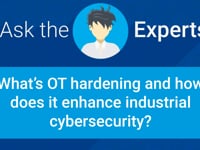Key Steps Before Implementing Hardening Controls in Industrial Control System (ICS) Networks
Before applying hardening controls, organizations should take a structured approach:
1. Asset Management: Identify and classify all OT cyber assets. Prioritize those that need to be fully secured versus the ones that are less critical within the ICS environment.
2. Risk Assessment: Perform a thorough risk assessment to evaluate potential threats, vulnerabilities and the likelihood of exploitation for each specific asset that’s reviewed in the asset management phase.
3. Network Topology: Understand current communication pathways and identify opportunities to segment and secure the OT network more effectively.
4. Vendor Collaboration: Engage with vendors early. It’s critical to ensure alignment on hardening activities to maintain system integrity and supportability.
Key Strategies to Implement Hardening in Operational Technology (OT) Environments
Effective hardening in OT/ICS networks requires a combination of technical controls and strategic planning:
- Role-Based Access Control (RBAC): Implementing RBAC ensures that individuals only have access to the systems and data necessary for their specific roles. This minimizes the risk of unauthorized access and limits the potential impact of compromised credentials.
Assign permissions based on job responsibilities
Enforce the principle of least privilege
Regularly review and update access rights
- Network Segmentation: Dividing the network into distinct zones and conduits helps isolate critical systems and control communication pathways. This reduces the risk of lateral movement by attackers and enhances overall network security.
Segment ICS networks from corporate IT networks
Use firewalls, VLANs and DMZs to control traffic
Secure any internet-facing components with layered defenses
Regulations and Frameworks Supporting (Operational Technology) OT Hardening
International standards and regulations recommend or require OT cybersecurity hardening for critical infrastructure protection:
- ISA/IEC 62443: Defines security levels and prescribes controls for ICS/SCADA systems.
- NIST Standards: Including NIST 800-53 and 800-82, which provide detailed guidance on securing OT environments.
- U.S. Department of Homeland Security’s Cybersecurity and Infrastructure Security Agency (CISA), the Canadian Centre for Cyber Security, the Australian Cyber Security Centre (ACSC) and the Asia-Pacific joint OT cybersecurity guidance initiative have guidelines and best practices for system hardening in OT environments.
- NERC CIP (USA) and NIS2 Directive (EU) mandate hardening controls as part of compliance for critical infrastructure.






